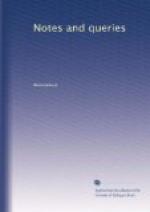R.J.
Mildew in Books.—Can you, or any of your readers, suggest a preventive for mildew in books?
In a valuable public library in this town (Liverpool), much injury has been occasioned by mildew, the operations of which appear very capricious; in some cases attacking the printed part of an engraving, leaving the margin unaffected; in others attacking the inside of the backs only; and in a few instances it attacks all parts with the utmost impartiality.
Any hints as to cause or remedy will be most acceptable.
B.
George Herbert’s Burial-place.—Can any of your correspondents inform me where the venerable George Herbert, rector of Bemerton, co. Wilts., was buried, and whether there is any monument of him existing in any church?
J.R. Fox.
The Earl of Essex, and “The Finding of the Rayned Deer."—
“There is a boke printed at Franker in Friseland, in English, entitled The Finding of the Rayned Deer, but it bears title to be printed in Antwerp, it should say to be done by som prieste in defence of the late Essex’s tumult.”
The above is the postscript to a letter of the celebrated Father Parsons written “to one Eure, in England”, April 30, 1601, a contemporary copy of which exists in the State Paper Office [Rome,] Whitehall. Can any of your readers tell me whether anything is known of this book?
SPES.
June 28. 1850.
The Lass of Richmond Hill.—I should be much obliged by being informed who wrote the words of the above song, and when, if it was produced originally at some place of public entertainment. The Rev. Thomas Maurice, in his elegant poem on Richmond Hill, has considered it to have been written upon a Miss Crop, who committed suicide on that spot, April 23rd, 1782; but he was evidently misinformed, as it appeared some few years later, and had no reference to that event. I have heard it attributed to Leonard Mac Nally, a writer of some dramatic pieces, but on no certain grounds; and it may have been a Vauxhall song about the year 1788. The music was by James Hook, the father of Theodore Hook.




